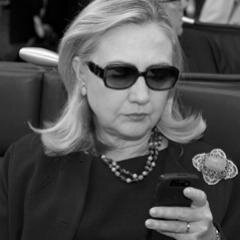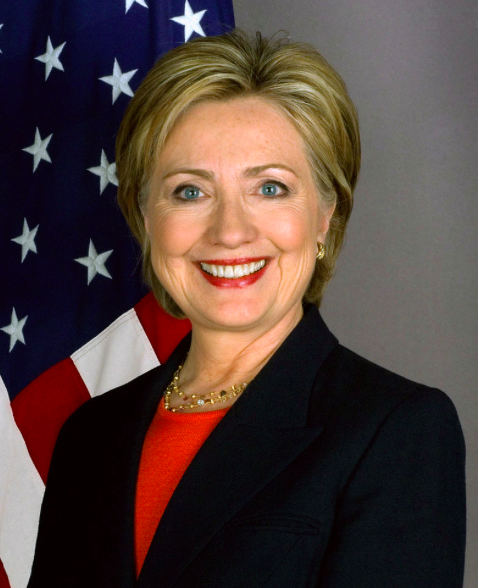The Clearest (No Spin) Summary of FBI Report on Hillary Clinton Email

Since this article refers to both President and Mrs. Clinton, they are sometimes referred to by their first names for clarity.
Most of the information is from the FBI report. Some contextual facts and dates have been added.
The Takeaways. The Players. The Timeline.
The Takeaways
The FBI could not review all of the Hillary Clinton emails under investigation because:
- The Clintons’ Apple personal server used for Hillary Clinton work email could not be located for the FBI to examine.
- An Apple MacBook laptop and thumb drive that contained Hillary Clinton email archives were lost, and the FBI couldn’t examine them.
- 2 BlackBerry devices provided to FBI didn’t have their SIM or SD data cards.
- 13 Hillary Clinton personal mobile devices were lost, discarded or destroyed. Therefore, the FBI couldn’t examine them.
- Various server backups were deleted over time, so the FBI couldn’t examine them.
- After State Dept. notified Hillary Clinton her records would be sought by House Benghazi Committee, copies of her email on the laptops of her attorneys Cheryl Mills and Heather Samuelson were wiped with BleachBit, and the FBI couldn’t review them.
- After her emails were subpoenaed, Hillary Clinton’s email archive was also permanently deleted from her then-server “PRN” with BleachBit, and the FBI couldn’t review it.
- Also after the subpoena, backups of the PRN server were manually deleted.
- 2,093 emails State Dept. currently classifies as Confidential or Secret. (State Dept. did not address what their classification was at the time they were sent.)
- 193 emails (81 separate email conversations) that were classified at the time they were sent, ranging from “Confidential” to “Top Secret/Special Access Program.”
- 68 of the 81 email chains remain classified today.
- 8 were Top Secret.
- 37 were Secret.
- 36 were Confidential.
- 7 were Special Access Program.
- 3 were Sensitive Compartmentalized Information.
- 36 were Not Releasing to Foreign Governments.
- 2 were Releasable Only to Five Allied Partners.
- 12 of the suspect email chains were not provided by Hillary’s attorneys. The FBI found them other ways.
- The email chains contained classified information from 5 other agencies: CIA, DOD, FBI, NGA and NSA.
The Players (as they surface in timeline)
Justin Cooper: President Bill Clinton aide
Bryan Pagliano: Computer technician from Hillary Clinton ‘08 campaign
Huma Abedin: Hillary Clinton aide
Eric Boswell: State Dept. Assistant Secretary for Diplomatic Security
John Bentel: State Dept. Information Technology official who handled Hillary Clinton’s issues
Jake Sullivan: Hillary Clinton aide
Cheryl Mills: Hillary Clinton chief of staff and attorney
Raymond Maxwell: Former State Dept. Deputy Assistant Secretary
Monica Hanley: Hillary Clinton aide
Sid Blumenthal: Hillary Clinton friend and adviser
Heather Samuelson: Hillary Clinton campaign worker and attorney
David Kendall of Williams & Connolly: Hillary Clinton attorney
3 Known Clinton Private Servers: Apple, “Pagliano,” and Platte River Networks (PRN)
The Timeline
2007: Hillary Clinton announces run for President. Bill Clinton aide Justin Cooper buys an Apple server for a new email system to be located in the Clintons’ Chappaqua, NY residence.
June 2008: Hillary drops out of Presidential race. Cooper sets up the Apple server.
Fall 2008: Hillary aide Huma Abedin contacts Hillary campaign computer tech Bryan Pagliano to build 2nd server because the Apple—in use for just a few months—is “antiquated.”
Jan. 2009: Hillary begins transitioning from her personal BlackBerry.net email to a clintonemail.com account on the “antiquated” Apple server.
Jan. 11, 2009: Increase in cyberattack attempts on State Dept. employee personal email accounts.
Jan. 21, 2009: Hillary becomes secretary of state. She declines a State Dept. email address and instead uses her personal BlackBerry in office.
Feb. 2009: Hillary travels to Asia, her first overseas trip as secretary of state.
March 2, 2009: Security memo warns Hillary and Chief of Staff Cheryl Mills that it’s risky to use their personal email and BlackBerry devices.
I cannot stress too strongly…that any unclassified BlackBerry is highly vulnerable in any setting to remotely and covertly monitoring conversations, retrieving e-mails, and exploiting calendars. –State Dept. memo from Eric Boswell of Diplomatic Security 3/2/2009.
March 2009: State Dept. official handling Hillary computer security issues, John Bentel, reportedly receives memo showing that Hillary’s private server was set to be installed at her NY home. Bentel would later tell FBI he didn’t know Hillary was using a personal account or server.
March 18, 2009: The server installed by Pagliano replaces the Apple, but Pagliano later tells FBI he didn’t transfer Hillary’s clintonemail.com account. The FBI could never locate or examine Apple server to determine facts.
Feb. 9, 2011: State Dept. staff again raises concerns about Hillary and staff using electronic devices in their offices.
March 2, 2011: State Dept. detects malicious cyber activity aimed at senior officials.
April 2011: Hillary’s immediate staff is briefed again on cybersecurity threats.
May 2011: Hillary’s immediate staff is briefed again.
Aug. 30, 2011: Hillary requests a government device to replace her broken BlackBerry. After she’s told it would be subject to Freedom of Information Act records searches, no government device is issued.
2011: Memo from Hillary cautions State Dept. employees about security and records retention, and advises not to use personal email for government business.
Sept. 11, 2012: Islamic extremist terrorists attack Americans in Benghazi, Libya.
Nov. 2012: State Dept. Accountability Review Board convenes to investigate Benghazi. Hillary aides Cheryl Mills and Jake Sullivan are reportedly seen at allegedly improper Benghazi “document sorting” session in State Dept. basement.
Week of Dec. 9, 2012: Hillary faints and falls, suffering a concussion. State Dept. keeps it secret for several days.
Dec. 4, 2012:
- Congressional investigators try to schedule interview with Bentel, Hillary’s State Dept. information technology officer.
- He declines.
- He retires from State Dept. in December.
Dec. 15, 2012: Hillary postpones her Congressional testimony on Benghazi due to illness.
Dec. 30, 2012: State Dept. discloses discovery of “blood clot” in Clinton’s head from the concussion.
Early 2013: Pagliano plans to seek other work. Clinton staff begins searching for vendor to manage a new, 3rd Clinton email server.
Jan. 2, 2013: Platte River Networks of Denver (PRN) wins contract for new Clinton server.
Jan. 7, 2013: Hillary returns to work.
Jan. 23, 2013: Hillary testifies to Congress on Benghazi attacks.
Feb. 1, 2013: Hillary’s last day as secretary of state. She fails to produce her federal records as required by law.
Spring 2013:
- Hillary aide Monica Hanley and Cooper put Hillary email archive on an Apple MacBook laptop and thumb drive.
- But Hanley later tells FBI she forgot to give laptop and thumb drive to Hillary’s staff.
- The laptop and thumb drive are lost and the FBI cannot examine.
March 14, 2013: Hillary confidant Sid Blumenthal’s AOL email is hacked by Romanian cyber hacker “Guccifer,” uncovering a memo to Hillary with classified “confidential” information.
June 2013: According to a book later written by Bill, Hillary finally recovers from her Dec. 2012 illness about now.
June 23, 2013: Pagliano server is moved to Equinix datacenter, NJ which “serves the world’s largest financial, media, and enterprise companies.”
Read: The Definitive Hillary Email Timeline (prior to FBI report)
June 30, 2013: Pagliano server email accounts are transferred to the new PRN server.
July 18, 2013: Clintons sign formal deal with PRN for new email server.
Early 2014: Hanley says she finds Apple MacBook laptop from Spring of 2013 at her home and tries, but fails, to remotely transfer Hillary email archive to PRN server.
Feb. 2014:
- Hanley ships Apple MacBook laptop to unidentified person who transfers Hillary email archive to Gmail address, then to PRN server.
- Hanley instructs unidentified person to delete and/or wipe Hillary email archive from Apple MacBook and Gmail.
- Unidentified person ships Apple MacBook via US Postal Service or UPS to unidentified female Hillary associate who later tells FBI she never received it.
- Nobody can find the Apple MacBook or thumb drive containing Hillary archive email.
May 8, 2014: House Benghazi committee is established.
Summer of 2014: State Dept. notifies Hillary aide Cheryl Mills that it will be requesting Hillary’s work emails.
July 23, 2014: Congressional Benghazi committee reaches agreement with State Dept. on production of records.
July 2014:
- Mills initiates review of any Hillary work emails with .gov addresses that were transferred from Pagliano server to PRN server.
- The emails don’t include the Jan-March 2009 emails lost on the missing Apple server.
- The .gov work emails are put in a file on laptops of Mills and Hillary attorney Heather Samuelson.
- These laptop email files would later be wiped using BleachBit so they could never be recovered. The FBI was unable to review them.
August, 2014: State Dept. provides House Benghazi Committee with eight emails to or from Clinton that show her use of a private email account.
Sept. 15, 2014: Sharyl Attkisson reports on State Dept. official who said he witnessed Benghazi document sorting session with Hillary aides in State Dept. basement in 2013.
Late Sept. 2014:
- Mills and Samuelson review the rest of the available Hillary emails, besides the .gov.
- These email files would later be wiped using BleachBit so they could never be recovered. The FBI was unable to review them.
- Selected emails are printed in Mills’ office and reviewed again by attorneys Samuelson, Mills and Hillary attorney David Kendall of Williams & Connolly.
- “Non-work” emails are shredded.
- “Work” emails were printed and provided on USB drive to Kendall.
Dec. 2014: Hillary and Abedin begin using new email accounts on the domain hrcoffice.com.
Dec. 5, 2014: Hard copies of Hillary work emails are given to State Dept.
Dec. 2014: Hillary instructs her staff she no longer needs to keep the remaining “personal” emails.
Dec. 2014 or Jan. 2015:
- Mills and Samuelson request unidentified person to delete the Hillary email files from their laptops.
- Software called “BleachBit” is used so it can never be recovered.
- Unknown Hillary staffer also wants Hillary email archive removed from PRN server.
- Mills asks for shortened email retention for clintonemail.com account because Hillary decides she no longer needs emails older than 60 days.
March 2, 2015:
- NYT article exposes fact that Clinton used personal email account exclusively for state business.
- PRN technicians conduct work on Pagliano server at Equinix datacenter.
- Mills later tells FBI they were working on the server because she asked them to conduct an equipment inventory.
March 4, 2015: House Benghazi committee privately subpoenas all Hillary emails related to Benghazi terrorist attacks. Clinton does not disclose the subpoenas but tweets, “I want the public to see my email. I asked State to release them. They said they will review them for release as soon as possible.”
March 9, 2015: Mills emails PRN and makes reference to the preservation request from Congress. A PRN technician would later tell FBI he doesn’t remember seeing it.
March 10, 2015: Clinton answers questions about her email practices for the first time. She tells reporters:
- It was more convenient to use the private server.
- “I wanted to use just one device for both personal and work emails instead of two.”
- Last year, she deleted nearly 31,000+ emails that were “private.”
- She will not turn over her personal email server.
- She “fully complied” with the law.
- She has turned over to the State Dept. 55,000 pages of work-related emails.
- There were 62,320 emails in her account: 30,490 were public business; 31,830 were private.
March 25, 2015:
- PRN has conference call with Bill Clinton’s staff.
- PRN technician later tells FBI that, at this point, he realized he’d forgotten to shorten Hillary’s email retention (that Mills requested in Dec. 2014), so he now deletes the Clinton archive mailbox from PRN and uses BleachBit to permanently delete files holding the emails.
- FBI says one PRN technician gave three conflicting stories but acknowledged that, when he made deletions, he knew of Congress’ preservation request and knew he should not delete Hillary’s email data on PRN server.
- The FBI says somebody also manually deleted backups of the PRN server during this time frame. Clinton and Mills say they were unaware of these deletions.
March 31, 2015: There’s a conference call among PRN, Kendall and Mills. Later, PRN would exert attorney-client privilege and refuse to comment on conversation. This means Hillary’s attorneys are representing the PRN technician, too.
May 27, 2015: In a Freedom of Information (FOI) lawsuit, the court orders State Dept. to post emails on FOI website on a monthly schedule to complete by Jan 29, 2016. (State completes Feb 29, 2016.)
July 28, 2015: Hillary revises her statement regarding classified email to say she is confident she never sent or received emails that were classified at the time. Later, the FBI would find Hillary sent or received 193 emails (81 separate email conversations) that were classified at the time they were sent, ranging from “Confidential” to “Top Secret/Special Access Program.”
July 31 2015: The federal judge in a Judicial Watch FOI suit, Emmet Sullivan, orders State Dept. to request that Mills and Abedin confirm, under penalty of perjury, that they have produced all government records in their possession, return any other government records immediately, and describe their use of Hillary’s email server to conduct government business.
Aug. 5, 2015: State Dept. sends letter to Hillary including Judge Sullivan’s order.
Aug. 6, 2015: Mills’ attorney tells Judicial Watch that it has instructed Mills to “delete any and all electronic copies [of potential federal records] in her possession” after her anticipated production of records on Aug. 10. Judicial Watch files an emergency request to block the destruction.
Aug. 11, 2015: Inspector General report to the Senate contradicts Hillary claims; some emails, says the IG, contained information that was classified at the time.
Aug. 19, 2015: Hillary’s personal lawyer tells a Senate committee that all data, including emails, was erased from her server prior to it being turned over to the FBI. Hillary tells reporters the investigation surrounding her server “has nothing to do with me.” She contradicts the Inspector General by reiterating that she never sent or received classified material.
Aug. 2015:
- FBI obtains Pagliano server.
- Williams & Connolly doesn’t disclose that there’s other related equipment, and that Hillary emails had been transferred to PRN server.
- PRN says, at this time, it realizes it’s accidentally backing up its Hillary server on the cloud rather than just locally as the Clintons had directed. It discontinues the cloud backups.
Sept. 10, 2015: Pagliano pleads the fifth before House Benghazi committee.
October, 2015: Previously withheld Hillary emails reveal she told daughter Chelsea almost immediately that terrorists were behind the Benghazi attacks, yet told the public they were prompted by a protest over a YouTube video.
Oct. 3, 2015: After learning about additional Pagliano server equipment, and that Hillary emails had been transferred to PRN server, FBI obtains equipment and PRN server.
Oct. 14, 2015: Hillary attorneys at Williams & Connolly review an iMac of Hillary’s and assure the Justice Dept. that no work emails were found on it.
Oct. 16, 2015: Williams & Connolly provides 2 Hillary Blackberry devices to FBI but forensics finds no evidence they were ever connected to her personal servers. They do not contain their SIM cards or SD secure digital cards.
Oct. 28, 2015: State Dept. sends formal request to Hillary and other former secretaries asking for their work-related emails. Hillary directs attorneys Kendall and Mills to oversee.
Jan. 7, 2016: FBI interviews Sid Blumenthal, who sent at least 24 memos currently classified “confidential” and at least one email classified as “Secret” at the time and currently to Hillary on unclassified system.
Feb. 9, 2016: Justice Dept. requests all of Hillary’s 13 mobile devices.
Feb. 22, 2016: Williams & Connolly tells DOJ it cannot locate any of the devices, so FBI was unable to examine the 13 mobile devices.
Feb 27, 2016: Jake Sullivan is interviewed by FBI. He says he’s not concerned emails with classified information that he sent to Hillary on unclassified system.
March 2016: Bentel declines to testify to Senate committee.
March 31, 2016: Guccifer is extradited from Romania to US.
April 5, 2016: FBI interviews Huma Abedin who sent at least one email classified as “confidential” to Hillary on her unclassified system.
April 9, 2016: Cheryl Mills is interviewed by FBI. She refuses to answer some questions under attorney-client privilege. She says she’s not concerned by her decision to send Hillary emails with information later deemed “classified” on her unclassified system.
May 25, 2016:
- State Dept. Inspector General (IG) says under Foreign Affairs Manual, employees are required to conduct day to day operations using authorized information system.
- IG says there’s “no evidence” Clinton sought approval to use her personal email account or private servers despite her obligation to do so.
June 22, 2016: Pagliano pleads the fifth 125 times in deposition with conservative watchdog Judicial Watch.
June 27, 2016: Attorney General Loretta Lynch meets privately with President Clinton. The two say it was a purely social visit.
July 2, 2016: FBI interviews Hillary Clinton.
July 4, 2016: Hillary indicates that, as President, she would likely keep Lynch as attorney general.
July 5, 2016: FBI Director James Comey recommends no prosecution in Hillary email case.
Sent from my iPhone


No comments:
Post a Comment